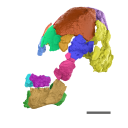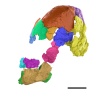3D models of Pontognathus ignotus and Massetognathus pascuali
3D models of early strepsirrhine primate teeth from North Africa
3D models of Protosilvestria sculpta and Coloboderes roqueprunetherion
3D GM dataset of bird skeletal variation
Skeletal embryonic development in the catshark
Bony connexions of the petrosal bone of extant hippos
bony labyrinth (11) , inner ear (10) , Eocene (8) , South America (8) , Paleobiogeography (7) , skull (7) , phylogeny (6)
Lionel Hautier (22) , Maëva Judith Orliac (21) , Laurent Marivaux (16) , Rodolphe Tabuce (14) , Bastien Mennecart (13) , Pierre-Olivier Antoine (12) , Renaud Lebrun (11)
MorphoMuseuM Volume 09, issue 04
<< prev. article next article >>

|
3D dataset3D model related to the publication: On Roth's "human fossil" from Baradero, Buenos Aires Province, Argentina: morphological and genetic analysisLumila P. Menéndez
Published online: 06/10/2023 |

|
M3#11983D virtual reconstruction of the skull Type: "3D_surfaces"doi: 10.18563/m3.sf.1198 state:published |
Download 3D surface file |
Hrdlička, A. (in collaboration with Holmes, W. H., Willis, B., Wright, F. E., & Fenner, C. N. (1912). Early man in South America. Bureau of American Ethnology, Bulletin 52. Washington D.C.: Smithsonian Institution.
Lehmann-Nitsche, R. (1907). Nouvelles recherches sur la formation pampéenne et l´ homme fossile de la République Argentine. Revista del Museo de La Plata, 14(1), 143–479.
Menéndez, L.P., Barbieri, C., López Cruz, I.G., Schmelzle, T., Breidenstein, A., Barquera, R., Borzi, G., Schuenemann, V., & Sánchez Villagra, M. 2023. On Roth’s “human fossil” from Baradero, Buenos Aires Province, Argentina: morphological and genetic analysis. Swiss Journal of Paleontology. https://doi.org/10.1186/s13358-023-00293-3
Roth, S. (1888). Beobachtungen über Entstehung und alter der Pampasformation in Argentinien. Zeitschrift der Deutschen geologischen Gesellschaft, 40, 375-464.https://doi.org/10.5962/bhl.title.15801
Lumila Paula Menéndez, Chiara Barbieri, Idalia Guadalupe López Cruz, Thomas Schmelzle, Abagail Breidenstein, Rodrigo Barquera, Guido Borzi, Verena J. Schuenemann and Marcelo R. Sánchez-Villagra (2023). On Roth’s “human fossil” from Baradero, Buenos Aires Province, Argentina: morphological and genetic analysis. Swiss Journal of Palaeontology. https://doi.org/10.1186/s13358-023-00293-3